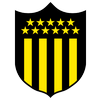CA Peñarol
Uruguay
Uruguayan Primera División
Est: 1891
Club Atlético Peñarol (Spanish pronunciation: [kluβ aˈtletiko peɲaˈɾol] ), more commonly referred to as Peñarol, is a Uruguayan professional football club based in Montevideo. The club currently competes in the Uruguayan Primera División, the highest tier in Uruguayan football.
The club takes its name from the Peñarol neighborhood, located in the northwest of the city. Currently, it plays in the Uruguayan Primera División.
Its origin dates back to September 28, 1891, with the creation of the Central Uruguay Railway Cricket Club (known by its acronym CURCC). There was a first attempt to change the name to CURCC Peñarol, but the CURCC board rejected the proposal by 25 votes to 12. On December 13, 1913, it became known as Peñarol, adopting the definitive name Club Atlético Peñarol on March 12, 1914. Some researchers, however, argue that although Peñarol inherited CURCC’s tradition and there is a sociological continuity between the two, legally they are different institutions, since CURCC continued to exist until 1915 (although only as a recreational branch for railway company employees). CURCC then sold its assets and donated the money obtained to the British Hospital of Montevideo, and therefore the founding date of the club would be December 13, 1913. This is the origin of the debate over the Decanato (who is the oldest club in Uruguay).
Although CURCC’s colors were originally black and orange, Peñarol throughout its history has always identified with yellow and black, taken from the Stephenson's Rocket locomotive and representative of the railway guild in general. Throughout its history it has engaged in various sports, standing out in basketball and cycling. Nevertheless, its dedication has been almost exclusively to football, the sport through which it has gained wide recognition.
The club plays its home matches at the Estadio Campeón del Siglo, inaugurated at the end of March 2016 with a capacity for 40,005 spectators. It is located on Route 102 between Camino Mangangá and Camino de los Siete Cerros, in the department of Montevideo. Previously, Peñarol played for several decades at the Estadio Centenario, which is municipally owned. The club also has a basketball arena (Palacio Contador Gastón Guelfi) and a training ground (Complejo Deportivo Washington Cataldi).
At the local level, in the professional era Peñarol has won 42 league titles, and considering the amateur era and the tournaments won by CURCC, it has won 51 titles. Additionally, Peñarol was champion of the Uruguayan Football Federation (FUF) in 1924 and of the Provisional Council Tournament in 1926. Internationally, it is the third club with the most Copa Libertadores titles, five times, and the first to win the Intercontinental Cup three times, a distinction it shares with four other clubs. It has also won the Supercopa de Campeones Intercontinentales once.
Its classic rival in Uruguayan football is Club Nacional de Football. This is one of the oldest and most celebrated rivalries in football (8 Libertadores and 6 Intercontinental Cups between them), with Peñarol holding the historical advantage.
In September 2009, it was declared the South American Club of the 20th Century by the International Federation of Football History & Statistics (IFFHS) with 531.00 points, surpassing Independiente of Argentina (426.50) and Nacional (414.00).
▤ Read more 
 Premier League
Premier League La Liga
La Liga Bundesliga
Bundesliga Serie A
Serie A Ligue 1
Ligue 1 Liga Portugal
Liga Portugal Eredivisie
Eredivisie Süper Lig
Süper Lig MLS
MLS Série A
Série A J1 League
J1 League Saudi Pro League
Saudi Pro League WSL
WSL Première Ligue
Première Ligue NWSL
NWSL






 YouTube
YouTube





























 •Youtube
•Youtube







